Your business needs reliable floodlights, but the choices are confusing. The wrong decision leads to high costs and constant maintenance. Let’s compare LED and halogen to find the best fit.
LED floodlights are overwhelmingly better for most businesses. They offer massive energy savings, a much longer lifespan, and greater durability. Halogens are cheaper upfront but cost far more in electricity and replacements over time, making LEDs the smarter long-term investment.
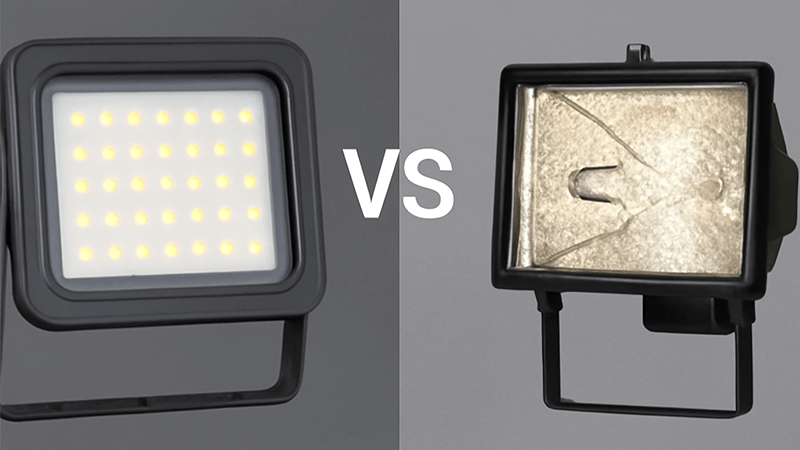
I get it. The initial low price of halogen floodlights can be tempting. I’ve seen many purchasing managers like Shaz in the UAE focus on that first cost. But my years in the lighting industry have taught me that the real cost of lighting is not just the price on the box. It’s about energy, maintenance, and performance over many years. So, let’s break down the details to see the full picture.
Which is better, halogen or LED flood lights?
Deciding between halogen and LED feels like a big commitment. Choosing poorly can lead to budget overruns and performance issues. Let’s compare them directly to see which one wins.
For almost every business application, LED floodlights are better. They use up to 90% less energy, last over 20 times longer, and are more durable. While halogens have a slight edge in color rendering for specific tasks, LEDs offer the best overall value and reliability.
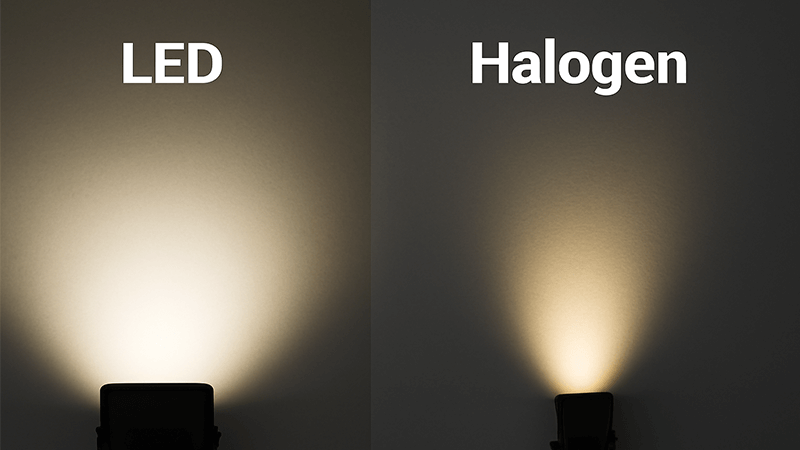
When I started in my first LED lighting factory, halogens were still very common. But the technology has moved forward so fast. For a business, the choice comes down to a few key factors that impact your budget and operations. Let’s look at them closely.
Total Cost of Ownership
Halogens are cheap to buy. That is their main selling point. But as a purchasing manager, you have to look at the total cost over the product’s life. This includes the purchase price, electricity bills, and the cost of replacement bulbs and labor. When you add it all up, LEDs are much, much cheaper in the long run. I worked with a client in Dubai who managed a large parking lot. They switched from 1000W halogen fixtures to my 200W LED floodlights. Their electricity bill for lighting dropped by over 80%. The savings paid for the new LED lights in just under two years. After that, it was pure profit for them.
Performance and Lifespan
The difference here is huge. A typical halogen floodlight bulb might last 2,000 hours. A good quality LED floodlight, like the ones we manufacture at iPHD, can last 50,000 hours or more. That means for every one LED floodlight’s lifespan, you would have to buy and replace the halogen bulb 25 times. Think about the cost of labor and equipment, like a scissor lift, to change a bulb on a high pole. Those "soft costs" add up very quickly.
Here is a simple comparison:
| Feature |
Halogen Floodlight |
LED Floodlight |
| Lifespan |
~2,000 hours |
50,000+ hours |
| Energy Use |
Very High |
Very Low (up to 90% less) |
| Heat Output |
Very High (Fire risk) |
Low (Safer) |
| Durability |
Fragile filament |
Solid-state, very durable |
| Upfront Cost |
Low |
High |
| Long-Term Cost |
Very High |
Very Low |
The numbers on this table make the decision simple. For any business that thinks about long-term value and operational efficiency, LED is the only logical choice.
Why are halogen lights being banned?
Hearing that a product you use is being banned is concerning. It creates uncertainty about future supply and regulations for your projects. Let’s clarify why this global shift is happening.
Halogen lights are being phased out globally because they are extremely inefficient. Most of the energy they consume is wasted as heat, not light. This goes against modern energy efficiency standards and environmental goals designed to reduce electricity consumption and carbon emissions.
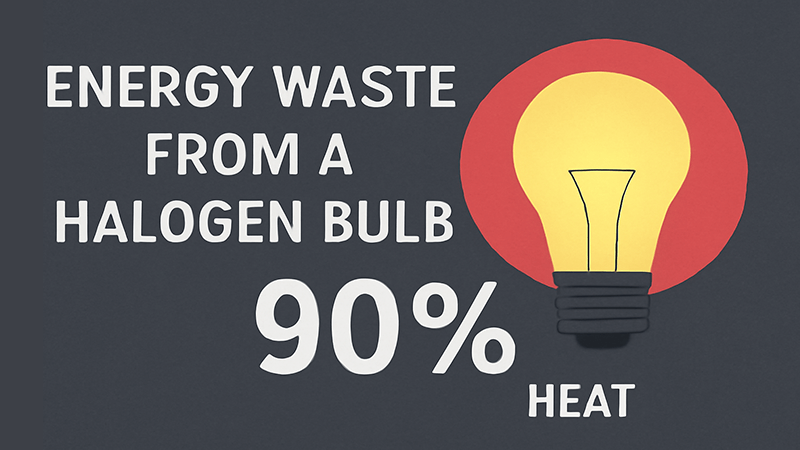
The global move away from halogen bulbs isn’t a random decision. It’s based on simple physics and a drive for a more sustainable future. Governments around the world, from the European Union to countries across Asia, are implementing these phase-outs for very practical reasons that directly impact businesses.
Extreme Energy Inefficiency
The biggest reason for the ban is waste. A halogen bulb works by heating a tiny wire filament inside the bulb until it glows brightly. You can think of it as a small electric heater that also happens to produce some light as a byproduct. Over 90% of the electricity it uses is converted directly into heat. Only a tiny fraction, less than 10%, becomes visible light. In a world where energy costs are rising and we are all focused on reducing consumption, this level of waste is no longer acceptable. LEDs are the opposite. They are highly efficient and convert most of the electricity directly into light, producing very little waste heat in the process.
Environmental and Safety Concerns
All that wasted energy has a direct environmental impact. It means power plants have to burn more fuel to power the lights, which increases carbon emissions and pollution. By switching to LED technology, we can dramatically reduce the demand for electricity on a global scale. I remember providing a custom lighting plan for a large sports facility. The heat from their old halogen floodlights was so intense that it was a constant safety worry for the facility manager, especially in their hot climate. The switch to my cooler-running LED floodlights not only saved them a fortune in energy but also eliminated a major fire hazard. This extreme heat is another key reason regulators want halogens gone. They are a known safety risk because they can easily ignite nearby materials if not installed with extreme care.
Do LED lights work in cold weather?
Installing outdoor lights in cold regions brings a unique challenge. You worry if the lights will even turn on in freezing weather. This failure can create serious safety hazards.
Yes, LED lights work exceptionally well in cold weather. Unlike other lighting technologies that struggle in the cold, LEDs actually become more efficient and can have a longer lifespan in lower temperatures. Their solid-state nature makes them reliable and instant-on, even in sub-zero conditions.
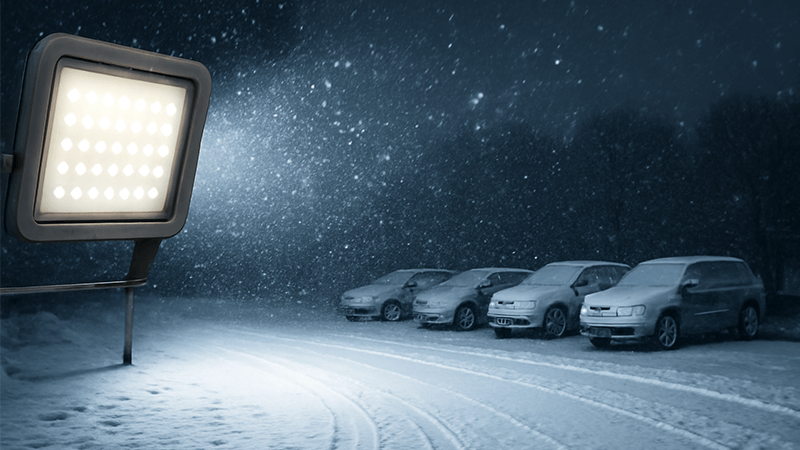
This is a question I get all the time from project contractors I work with in Northern Europe and Canada. It’s a very important concern because many older lighting types, like fluorescent tubes, can flicker, dim, or fail to start at all in the cold. Halogens can also be stressed by rapid temperature changes, causing the glass to crack. But with LEDs, the story is completely different and is a major advantage.
The Science of LEDs in the Cold
LEDs are semiconductors, which are solid-state devices. They are not dependent on heating a gas or a filament to produce light. This is key. In fact, cold temperatures actually help the semiconductor process work better. The low temperature reduces the electrical resistance within the tiny LED chip. This means the LED can convert electricity to light even more efficiently than it does at room temperature. The result is a slightly higher light output and a potentially longer operational life. This is the complete opposite of how most other light sources behave.
Practical Advantages in Freezing Conditions
One of the best features of LEDs in the cold is that they provide "instant-on" light at full brightness. There is no warm-up time at all. You flip the switch, and you get 100% of the light immediately, even if it’s -20°C outside. This is critical for security and safety lighting in places like commercial parking lots, building perimeters, and logistics depots. A few years ago, I supplied custom IP66-rated floodlights for a shipping port in a very cold part of Canada. The purchasing manager told me their previous HID lights would take several minutes to reach full brightness on cold winter mornings. My LED solution gave them instant, reliable light, which improved safety and productivity for their early morning shifts. The most important thing is to ensure the entire fixture, especially the power supply (the driver), is rated for cold temperatures. A high-quality outdoor LED floodlight will always be designed and tested for these exact conditions.
What are the disadvantages of halogen light bulbs?
The low initial price of halogen bulbs is attractive. But this saving hides several serious drawbacks that can cost your business much more in the long run. Let’s look closer.
Halogens have many disadvantages. They are very inefficient, turning most energy into dangerous heat. They have extremely short lifespans, requiring frequent replacements. Their glass bulbs and fine filaments are fragile and sensitive to touch, and they produce significant UV radiation, which can fade materials.
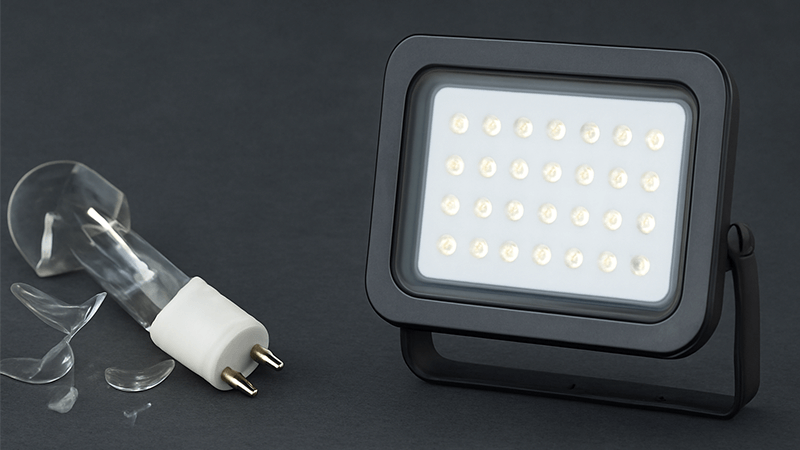
I have spent my career helping clients like you move away from old technology like halogen. While these bulbs served a purpose decades ago, their disadvantages are simply too significant for modern businesses to ignore. Beyond the extreme inefficiency and high energy costs we already talked about, there are other major problems you need to be aware of.
Heat, Safety, and UV Radiation
Halogen bulbs operate at extremely high temperatures. The surface of the bulb can get hot enough to cause severe burns or start a fire if it gets too close to flammable materials like wood, fabric, or insulation. This requires very careful installation and creates a constant safety risk. They also emit a significant amount of UV radiation. I once visited a retail store that used halogen track lighting to spotlight their merchandise. Over time, the colors in their fabrics started to fade badly because of the constant UV exposure. LEDs produce virtually no UV radiation, making them much safer for illuminating sensitive materials and for people working nearby.
Short Lifespan and Fragility
As I mentioned, a 2,000-hour lifespan is very short for a commercial product. But the problem is also their physical fragility. The glass bulb contains a delicate tungsten filament that is thinner than a human hair. Any significant vibration or shock—common in industrial sites, construction zones, or near roadways—can break it. Even touching the glass bulb with your bare fingers during installation can be a problem. The oil from your skin can create a hot spot on the bulb’s surface, causing it to fail much faster. This makes them a terrible choice for any application that isn’t perfectly stable and clean.
Here is a summary of the main issues:
| Disadvantage |
Description |
| High Heat |
Creates a fire and burn risk. Increases building cooling costs. |
| Short Lifespan |
Requires frequent, costly, and difficult replacements. |
| Fragile Design |
Easily broken by vibration or improper handling. |
| UV Emission |
Can damage and fade fabrics, artwork, and materials over time. |
| High Energy Waste |
Wastes over 90% of your electricity bill as heat. |
The only area where halogen still technically wins is its perfect Color Rendering Index (CRI) of 100, which perfectly mimics natural sunlight. But for the vast majority of floodlighting applications like squares, parking lots, and warehouses, a high-quality LED with a CRI of over 80 provides a color appearance that is more than sufficient. The huge benefits of LED far outweigh this now very small difference in light quality.
Conclusion
For your business, the choice is clear. LED floodlights save money, improve safety, and last longer. They are the smart, reliable, and future-proof investment for any lighting project.